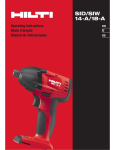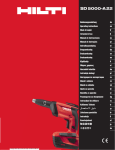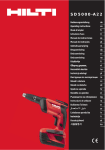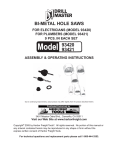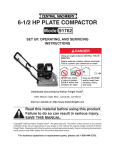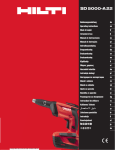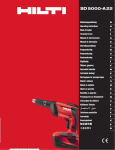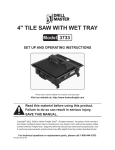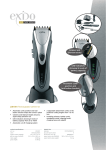Download Hilti 3497777 Use and Care Manual
Transcript
SD 4500-A18 Operating instructions en Mode d’emploi fr Manual de instrucciones es Manual de instruções pt 1 7 6 5 +“ +# +≠ 4 2 1 3 8 9 +± This Product is Certified Ce produit est homologué Producto homologado por Este produto está registrado C US 2 3 4 5 6 1 2 3 7 8 1/2 2 9 10 11 3 2 ORIGINAL OPERATING INSTRUCTIONS SD 4500‑A18 Drywall screwdriver en It is essential that the operating instructions are read before the power tool is operated for the first time. Always keep these operating instructions together with the power tool. Ensure that the operating instructions are with the power tool when it is given to other persons. Contents 1. General information 2. Description 3. Insert tools, accessories 4. Technical data 5. Spare parts 6. Safety instructions 7. Before use 8. Operation 9. Care and maintenance 10. Troubleshooting 11. Disposal 12. Manufacturer’s warranty - tools Page 1 2 4 4 5 5 8 9 10 11 12 13 1 These numbers refer to the corresponding illustrations. The illustrations can be found on the fold-out cover pages. Keep these pages open while studying the operating instructions. In these operating instructions, the designation “power tool” always refers to the SD 4500‑A18 drywall screwdriver. Parts, operating controls and indicators 1 @ Control switch (with electronic speed control) ; Forward / reverse switch = Lockbutton for sustained operation % Depth gauge & Power tool / accessory interface (click connection) ( Chuck (bit holder) ) Bit holder + Air exit § Belt hook / Grip : Battery release buttons · Motor cooling air intake $ Universal hook 1. General information 1.1 Safety notices and their meaning DANGER Draws attention to imminent danger that could lead to serious bodily injury or fatality. WARNING Draws attention to a potentially dangerous situation that could lead to serious personal injury or fatality. CAUTION Draws attention to a potentially dangerous situation that could lead to slight personal injury or damage to the equipment or other property. NOTE Draws attention to an instruction or other useful information. 1.2 Explanation of the pictograms and other information Warning signs General warning Warning: electricity Warning: caustic substances 1 Obligation signs Wear eye protection en Location of identification data on the power tool The type designation and serial number can be found on the type identification plate on the machine or tool. Make a note of this data in your operating instructions and always refer to it when making an enquiry to your Hilti representative or service department. Wear protective gloves Type: Symbols Generation: 01 Serial no.: Read the operating instructions before use Return waste material for recycling. Volts Rated speed under no load Revolutions per minute Diameter Direct current 2. Description 2.1 Use of the product as directed The SD 4500-A18 is a hand-held cordless drywall screwdriver with automatic clutch. Drywall screws with a length of up to 55 mm and a diameter of up to 4.2 mm can be used. Do not use other types of screws intended for heavy-duty applications. For optimum handling, we recommend that the power tool is gripped in line with the motor. The air required for motor cooling is drawn in through the ventilation slots and blown out of the tool through the air exit. The power tool is suitable for use by right or left-handed persons. An ergonomically designed grip with synthetic rubber covering provides a comfortable, secure hold and makes the power tool less tiring to use. The power tool is designed for professional use and may be operated, serviced and maintained only by trained, authorized personnel. This personnel must be informed of any special hazards that may be encountered. The power tool and its ancillary equipment may present hazards when used incorrectly by untrained personnel or when used not as directed. Observe the information printed in the operating instructions concerning operation, care and maintenance. To avoid the risk of injury, use only genuine Hilti accessories and insert tools. Do not use the battery as a power source for other unspecified appliances. Working on materials hazardous to the health (e.g. asbestos) is not permissible. Nationally applicable industrial safety regulations must be observed. Do not use the power tool where there is a risk of fire or explosion. Modification of the power tool or tampering with its parts is not permissible. The working environment may be as follows: construction site, workshop, renovation, conversion or new construction. 2 2.2 Main applications Application Screw type Drywall board to metal track (framing) ≦ 0.88 mm / 20 ga Drywall screw with needle point, type S‑DS01 Drywall screw with drill point, type S‑DD01 Drywall screws with drill point, types S‑DD02, S‑DD03 and S‑DD08 Drywall screw with needle point, type S‑DS03 Drywall screws with needle point, types S‑DS14 and S‑DS10 Drywall board to metal track (framing) ≦ 2.25 mm / 16 - 25 ga Metal track to metal track (max. thickness of part fastened 2.5 mm / 13 - 12 ga) Fastening drywall board to timber Gypsum fiber board to metal track (≦0.88 mm / 20 ga) and timber framing en NOTE The power tool can also be used together with the SMD 57 magazine and the appropriate collated screws for the applications listed above. Please observe the operating instructions for the applicable drywall screw magazine. 2.3 Chuck ¼" bit holder 2.4 Switches Control switch for smooth speed control Lockbutton for sustained operation Forward / reverse switch 2.5 Lubrication Grease lubrication 2.6 Grips Vibration-absorbing grip (in-line grip) 2.7 The items supplied include (toolbox versions): 1 1 1 1 2 1 2 Power tool Depth gauge Bit Bit holder B 18/2.6 Li‑ion battery Charger for Li-ion batteries Operating instructions 2.8 The items supplied include (cardboard box versions): 1 1 1 Power tool Depth gauge Bit 3 1 1 Bit holder Operating instructions 2.9 Li‑ion battery charge status en LEDs light constantly LEDs blink - LED 1,2,3,4 LED 1,2,3 LED 1,2 LED 1 - LED 1 Charge status C C ≧ 75 % 50 % ≦ C < 75 % 25 % ≦ C < 50 % 10 % ≦ C < 25 % C < 10 % 3. Insert tools, accessories Depth gauge S‑DG‑D 11x75 for the 75mm (3") bit holder S‑BH 75M SMD 57 SME extension for working on ceilings Bit holder Magazine Extension Charger for Li-ion batteries Charger for Li-ion batteries Charger for Li-ion batteries Battery Hilti toolbox Bit C 4/36 C 4/36‑ACS C 4/36-ACS TPS B 18/2.6 Li‑ion S‑B PH2 4. Technical data Right of technical changes reserved. Power tool SD 4500‑A18 Rated voltage Weight Dimensions (L x W x H) 21.6 V 2.1 kg (4.6 lb) 253 mm (9.96") x 99 mm (3.9") x 235 mm (9.25") 0…4,200/min 9.5 Nm (84.0 in-lbs) Hex. socket ¹⁄₄" Rated speed under no load Max. torque Chuck 4 Battery B 18/2.6 Li-ion Rated voltage Capacity Energy content 21.6 V 2.6 Ah 56.16 Wh Battery B 18/2.6 Li-ion Weight Temperature monitoring Type of cell No. of cells 0.8 kg (1.8 lb) Yes Lithium-ion 12 en 5. Spare parts Depth gauge Bit holder SD 4500-A18 belt hook SD 4500-A18 universal hook S-DG-D 11 x 50 S‑BH 50M SD-A BH SD-A UH 406292 257257 406293 406294 6. Safety instructions 6.1 General power tool safety warnings WARNING! Read all safety warnings and all instructions. Failure to follow the warnings and instructions may result in electric shock, fire and/or serious injury. Save all warnings and instructions for future reference. The term “power tool” in the warnings refers to your mains‐operated (corded) power tool or battery‐operated (cordless) power tool. 6.1.1 Work area safety a) Keep work area clean and well lit. Cluttered or dark areas invite accidents. b) Do not operate power tools in explosive atmospheres, such as in the presence of flammable liquids, gases or dust. Power tools create sparks which may ignite the dust or fumes. c) Keep children and bystanders away while operating a power tool. Distractions can cause you to lose control. 6.1.2 Electrical safety a) Power tool plugs must match the outlet. Never modify the plug in any way. Do not use any adapter plugs with earthed (grounded) power tools. Unmodified plugs and matching outlets will reduce risk of electric shock. b) Avoid body contact with earthed or grounded surfaces, such as pipes, radiators, ranges and refrigerators. There is an increased risk of electric shock if your body is earthed or grounded. c) Do not expose power tools to rain or wet conditions. Water entering a power tool will increase the risk of electric shock. d) Do not abuse the cord. Never use the cord for carrying, pulling or unplugging the power tool. Keep cord away from heat, oil, sharp edges or moving parts. Damaged or entangled cords increase the risk of electric shock. e) When operating a power tool outdoors, use an extension cord suitable for outdoor use. Use of a cord suitable for outdoor use reduces the risk of electric shock. f) If operating a power tool in a damp location is unavoidable, use a residual current device (RCD) protected supply. Use of an RCD reduces the risk of electric shock. 6.1.3 Personal safety a) Stay alert, watch what you are doing and use common sense when operating a power tool. Do not use a power tool while you are tired or under the influence of drugs, alcohol or medication. A moment of inattention while operating power tools may result in serious personal injury. b) Use personal protective equipment. Always wear eye protection. Protective equipment such as dust mask, non-skid safety shoes, hard hat, or hearing protection used for appropriate conditions will reduce personal injuries. 5 en c) Prevent unintentional starting. Ensure the switch is in the off‐position before connecting to power source and/or battery pack, picking up or carrying the tool. Carrying power tools with your finger on the switch or energising power tools that have the switch on invites accidents. d) Remove any adjusting key or wrench before turning the power tool on. A wrench or a key left attached to a rotating part of the power tool may result in personal injury. e) Do not overreach. Keep proper footing and balance at all times. This enables better control of the power tool in unexpected situations. f) Dress properly. Do not wear loose clothing or jewellery. Keep your hair, clothing and gloves away from moving parts. Loose clothes, jewellery or long hair can be caught in moving parts. g) If devices are provided for the connection of dust extraction and collection facilities, ensure these are connected and properly used. Use of dust collection can reduce dust-related hazards. 6.1.4 Power tool use and care a) Do not force the power tool. Use the correct power tool for your application. The correct power tool will do the job better and safer at the rate for which it was designed. b) Do not use the power tool if the switch does not turn it on and off. Any power tool that cannot be controlled with the switch is dangerous and must be repaired. c) Disconnect the plug from the power source and/or the battery pack from the power tool before making any adjustments, changing accessories, or storing power tools. Such preventive safety measures reduce the risk of starting the power tool accidentally. d) Store idle power tools out of the reach of children and do not allow persons unfamiliar with the power tool or these instructions to operate the power tool. Power tools are dangerous in the hands of untrained users. e) Maintain power tools. Check for misalignment or binding of moving parts, breakage of parts and any other condition that may affect the power tool’s operation. If damaged, have the power tool repaired before use. Many accidents are caused by poorly maintained power tools. f) Keep cutting tools sharp and clean. Properly maintained cutting tools with sharp cutting edges are less likely to bind and are easier to control. 6 g) Use the power tool, accessories and tool bits etc. in accordance with these instructions, taking into account the working conditions and the work to be performed. Use of the power tool for operations different from those intended could result in a hazardous situation. 6.1.5 Battery tool use and care a) Recharge only with the charger specified by the manufacturer. A charger that is suitable for one type of battery pack may create a risk of fire when used with another battery pack. b) Use power tools only with specifically designated battery packs. Use of any other battery packs may create a risk of injury and fire. c) When battery pack is not in use, keep it away from other metal objects, like paper clips, coins, keys, nails, screws or other small metal objects, that can make a connection from one terminal to another. Shorting the battery terminals together may cause burns or a fire. d) Under abusive conditions, liquid may be ejected from the battery, avoid contact. If contact accidentally occurs, flush with water. If liquid contacts eyes, additionally seek medical help. Liquid ejected from the battery may cause irritation or burns. 6.1.6 Service a) Have your power tool serviced by a qualified repair person using only identical replacement parts. This will ensure that the safety of the power tool is maintained. 6.2 Additional safety rules 6.2.1 Personal safety a) Hold power tool by insulated gripping surfaces only, when performing an operation where the fastener may contact hidden wiring. Fasteners contacting a “live” wire may make exposed metal parts of the power tool “live” and shock the operator. b) It is recommended that ear protectors are worn. Exposure to noise can cause hearing loss. c) Keep the power tool, especially its grip surfaces, clean and free from oil and grease. Do not use cleaning agents which contain silicone. d) Improve the blood circulation in your fingers by relaxing your hands and exercising your fingers during breaks between working. e) Avoid touching rotating parts. Switch the power tool on only after bringing it into position at the workpiece. Touching rotating parts, especially rotating insert tools, may lead to injury. f) Activate the safety lock (forward / reverse switch in the middle position) before storing or transporting the power tool. g) Use the right power tool for the job. Do not use the power tool for purposes for which it was not intended. Use it only as directed and when in faultless condition. h) Avoid unintentional starting. Never carry the power tool with your finger on the on/off switch. Remove the battery from the power tool during work breaks, before carrying out maintenance, before changing cutting tools and before transporting the power tool. i) Check that the belt hook is fitted securely before beginning work. j) Do not carry the tool by the depth gauge. The depth gauge may pull off unexpectedly. k) Children must be instructed not to play with the appliance. l) The appliance is not intended for use by children, by debilitated persons or those who have received no instruction or training. m)WARNING: Some dust created by grinding, sanding, cutting and drilling contains chemicals known to cause cancer, birth defects, infertility or other reproductive harm; or serious and permanent respiratory or other injury. Some examples of these chemicals are: lead from leadbased paints, crystalline silica from bricks, concrete and other masonry products and natural stone, arsenic and chromium from chemicallytreated lumber. Your risk from these exposures varies, depending on how often you do this type of work. To reduce exposure to these chemicals, the operator and bystanders should work in a well-ventilated area, work with approved safety equipment, such as respiratory protection appropriate for the type of dust generated, and designed to filter out microscopic particles and direct dust away from the face and body. Avoid prolonged contact with dust. Wear protective clothing and wash exposed areas with soap and water. Allowing dust to get into your mouth, eyes, or to remain on your skin may promote absorption of harmful chemicals. n) Check that the power tool is placed in a secure position when it is laid down, especially when used with the magazine and / or extension. 6.2.2 Power tool use and care Check that the insert tools used are compatible with the chuck system and that they are secured in the chuck correctly. 6.2.3 Electrical safety Before beginning work, check the working area (e.g. using a metal detector) to ensure that no concealed electric cables or gas and water pipes are present. External metal parts of the power tool may become live, for example, when an electric cable is damaged accidentally. This presents a serious risk of electric shock. 6.2.4 Battery tool use and care a) Do not expose batteries to high temperatures or fire. This presents a risk of explosion. b) Batteries must not be opened or dismantled, squashed, heated to temperatures over 100°C or incinerated. A risk of fire, explosion or injury through contact with caustic substances may otherwise result. c) Do not use batteries other than those approved for use with the applicable power tool or appliance. Use of other batteries or use of the battery for purposes for which it is not intended presents a risk of fire and explosion. d) Observe the special instructions applicable to the transport, storage and use of Li-ion batteries. e) Avoid short-circuiting the battery. Check that the terminals on the battery and in the power tool are free from foreign objects before inserting the battery in the power tool. Short circuiting the battery terminals presents a risk of fire, explosion and chemical burns. f) Do not charge or continue to use damaged batteries (e.g. batteries with cracks, broken parts, bent or pushed-in and/or pulled-out contacts). 7 en 6.2.5 Work area Ensure that the workplace is well ventilated. Exposure to dust at a poorly ventilated workplace may result in damage to the health. en 6.2.6 Personal protective equipment The user and any other persons in the vicinity must wear suitable eye protection, a hard hat, protective gloves and breathing protection while the power tool is in use. 7. Before use 7.1 Battery use and care NOTE Battery performance drops at low temperatures. Never use the battery until the cells become fully discharged. Change to the second battery as soon as a drop in performance is noticed. Recharge the battery immediately so that it is ready for reuse. Store the battery in a cool, dry place. Never store the battery where it is exposed to direct sunlight or sources of heat, e.g. on heaters / radiators or behind a motor vehicle windscreen. Batteries that have reached the end of their life must be disposed of safely and correctly to avoid environmental pollution. 7.2 Charging the battery DANGER Use only the Hilti batteries and Hilti chargers listed under “Accessories”. 7.2.1 Charging a new battery for the first time A new battery must be charged correctly for the first time before use. This will ensure that the cells form correctly. Incorrect initial charging may have a permanent, negative effect on battery capacity. Please refer to the applicable battery charger’s operating instructions for information about initial charging. 8 7.2.2 Charging a previously used battery Ensure that the outer surfaces of the battery are clean and dry before inserting it in the corresponding charger. Read the operating instructions for the charger for further information about the charging procedure. Li-ion batteries are ready for use at any time, even when only partly charged. Charging progress is indicated by the LED display (see charger operating instructions). 7.3 Fitting the battery 2 3 CAUTION Before fitting the battery, check that the power tool is switched off and that the safety lock is engaged (forward/reverse switch in the middle position). Use only the Hilti batteries approved for use with this power tool. CAUTION Check that the terminals on the battery and in the power tool are free from foreign objects before inserting the battery in the power tool. 1. Push the battery into the power tool from the rear as far as it will go and until it is heard to engage with a double click. 2. CAUTION A falling battery may present a risk of injury to yourself or others. Check that the battery is seated securely in the power tool. 7.4 Removing the battery 4 1. Press both battery release buttons. 2. Pull the battery out of the power tool toward the rear. 8. Operation CAUTION Wear protective gloves when changing insert tools as the insert tools get hot during use. 1. Pull the depth gauge away from the power tool, releasing the click connection. The bit holder is then exposed and can be changed. 2. Push the chuck toward the power tool, turn it slightly and hold it securely. 3. Use the other hand to remove the bit holder. CAUTION Working on the material may cause it to splinter. Wear eye protection and protective gloves. Wear breathing protection if no dust removal system is used. Splintering material presents a risk of injury to the eyes and body. 8.4 Safe operation 7 WARNING Do not grip the power tool by the depth gauge or bit holder. A screw coming into contact with a concealed electric cable may result in electric shock. CAUTION Check that the accessories used are fitted securely. 8.5 Switching on / off The speed of the power tool can be controlled smoothly (increased from zero to maximum) by pressing the control switch gradually. 8.1 Setting forward or reverse rotation 5 NOTE The forward / reverse switch is used to select the direction of rotation of the drive spindle. An interlock prevents switching while the motor is running. The control switch is locked when the forward / reverse switch is in the middle position. Push the forward / reverse switch to the left (when the power tool is held in the working direction) to select forward rotation. Push the forward / reverse switch to the right (when the power tool is held in the working direction) to select reverse rotation. 8.2 Changing bits 1. Pull the depth gauge away from the power tool, releasing the click connection. 2. Pull the bit away from the power tool. 3. Fit the new bit. 4. Refit the depth gauge to the power tool. 8.3 Changing tools (bit holder, magazine bit) 6 NOTE The chuck features a standardized ¼" hex. socket for insert tools (bits, bit holder, bits for use with screw magazines). 8.6 Power tool overloading and overheating indicator NOTE The power tool is equipped with an electronic protection system to prevent overloading and overheating. The power tool switches itself off automatically in the event of overloading and overheating. After releasing the control switch, the power tool may not restart immediately when the switch is pressed again (while the power tool is cooling down). 8.7 Lockbutton for sustained operation NOTE The lockbutton for sustained operation allows the motor to run continuously without need for constant pressure on the control switch. 8.7.1 Switching on in sustained operating mode 8 1. Press the control switch fully. 2. While maintaining pressure on the control switch, press the lockbutton and then release the control switch. 9 en 8.7.2 Switching off after sustained operation Press the control switch. The lockbutton returns to its original position. 8.8 Power tool / depth gauge interface 9 en 1. Pull the depth gauge away from the power tool, releasing the click connection. 2. Pull the depth gauge forward, away from the power tool. With the drive spindle exposed in this way, the following operations can be carried out: Removing a previously-driven screw using reverse rotation, changing the bit holder, changing to magazine operation with the SMD 57 or redriving a screw. Read the operating instructions for the magazine for information about changing to magazine operation. 8.9 Removing a previously-driven screw 1. Remove the depth gauge or the magazine by pulling it forward, away from the power tool. 2. Set the forward / reverse switch to the reverse rotation position. 3. The screw can then be removed. 8.10 Reading the charge status LED display on Li‑ion batteries 10 NOTE The charge status cannot be indicated while the power tool is in operation. If LED 1 blinks, this simply indicates that the battery is either fully discharged or too hot for use (temperature above 80°C). The Li-ion battery features a charge status LED display. The charge status is indicated by the LEDs on the battery during charging (please refer to the operating instructions for the charger). When the battery is at rest (not in use), its charge status is indicated by the four LEDs on the battery for three seconds after pressing one of the battery release buttons. 8.11 Belt hook 11 CAUTION Check that the belt hook is fitted securely before beginning work. The belt hook allows the power tool to be attached to a belt worn by the operator. The belt hook can also be fitted to the other side of the power tool for used by left-handed persons. 1. Pull the battery out of the tool. 2. Fit the mounting plate into the guides provided. 3. Secure the belt hook with the two screws. 8.12 Universal hook CAUTION Check that the universal hook is fitted securely. Use the universal hook only when required. Lay the power tool down in a secure place when it is no longer in use. The universal hook can be used to attach the power tool to the operator’s belt or to other objects when not in use. The universal hook can be removed from the power tool if not required. To do this, release the two screws that secure the universal hook to the power tool. 9. Care and maintenance CAUTION Before beginning cleaning, remove the battery from the power tool in order to prevent unintentional starting. 9.1 Care of insert tools Clean off dirt and dust deposits adhering to the insert tools and protect them from corrosion by wiping the insert tools from time to time with an oil-soaked rag. 10 9.2 Care of the power tool CAUTION Keep the power tool, especially its grip surfaces, clean and free from oil and grease. Do not use cleaning agents which contain silicone. The outer casing of the power tool is made from impact-resistant plastic. Sections of the grip are made from a synthetic rubber material. Never operate the power tool when the ventilation slots are blocked. Clean the ventilation slots carefully using a dry brush. Do not permit foreign objects to enter the interior of the power tool. Clean the outside of the power tool at regular intervals with a slightly damp cloth. Do not use a spray, steam pressure cleaning equipment or running water for cleaning. This may negatively affect the electrical safety of the power tool. 9.3 Care of the Li-ion battery Avoid entrance of moisture. Charge the battery fully before using it for the first time. In order to achieve maximum battery life, stop discharging the battery as soon as a significant drop in performance is noticed. NOTE If use of the power tool continues, further battery discharge will be stopped automatically before the battery cells suffer damage. Charge the battery with the Hilti charger approved for use with Li-ion batteries. NOTE - A conditioning charge (as is required with NiCd or NiMH batteries) is not necessary. - Interruption of the charging procedure has no negative effect on battery life. - Charging can be started at any time with no negative effect on battery life. There is no memory effect (as with NiCd or NiMH batteries). - For best results, batteries should be stored fully charged in a cool dry place. Avoid charging the battery in places subject to high ambient temperatures (e.g. at a window) as this has an adverse effect on battery life and increases the rate of self-discharge. - If the battery no longer reaches full charge, it may have lost capacity due to aging or overstressing. It is possible to continue working with a battery in this condition but it should be replaced in good time. 9.4 Maintenance WARNING Repairs to the electrical section of the power tool may be carried out only by trained electrical specialists. Check all external parts of the power tool for damage at regular intervals and check that all controls operate faultlessly. Do not operate the power tool if parts are damaged or when the controls do not function faultlessly. If necessary, the power tool should be repaired by Hilti Service. 9.5 Checking the power tool after care and maintenance After carrying out care and maintenance work on the power tool, check that all protective and safety devices are fitted and that they function faultlessly. 10. Troubleshooting Fault Possible cause Remedy The power tool doesn’t run. The battery is discharged or fitted incorrectly. The battery must be heard to engage with a double click or, respectively, needs to be charged. Remove the battery from the power tool and contact Hilti Service. Release the control switch, reduce the load on the power tool and then press the switch again. Push the forward / reverse switch to the left or right. Electrical fault. The power tool switches itself off and all 4 LEDs on the battery blink. The control switch can’t be pressed, i.e. the switch is locked. The power tool runs but the screw cannot be driven. The overload cut-out has been activated. The forward / reverse switch is in the middle position (safety lock engaged). The forward / reverse switch is set to the wrong direction of rotation. Push the forward / reverse switch to the left. 11 en Possible cause Remedy Running speed suddenly drops considerably. Speed cannot be controlled by the switch, it simply switches on / off. The battery doesn’t engage with an audible double click. The battery is discharged. Change the battery and recharge the discharged battery. Contact Hilti Service. The power tool or the battery gets very warm. Electrical fault. The control switch is defective. The retaining lugs on the battery are dirty. The power tool has been overloaded (application limits exceeded). Clean the retaining lugs and check that the battery engages securely. Contact Hilti Service if the problem persists. Switch the power tool off immediately, remove the battery and contact Hilti Service. Use the right power tool for the job (don’t use a low-powered tool for heavy work). 11. Disposal CAUTION Improper disposal of the equipment may have serious consequences: The burning of plastic components generates toxic fumes which may present a health hazard. Batteries may explode if damaged or exposed to very high temperatures, causing poisoning, burns, acid burns or environmental pollution. Careless disposal may permit unauthorized and improper use of the equipment. This may result in serious personal injury, injury to third parties and pollution of the environment. CAUTION Dispose of defective batteries without delay. Keep them out of reach of children. Do not attempt to open or dismantle batteries and do not dispose of them by incineration. CAUTION Dispose of the batteries in accordance with national regulations or return them to Hilti. Most of the materials from which Hilti power tools or appliances are manufactured can be recycled. The materials must be correctly separated before they can be recycled. In many countries, Hilti has already made arrangements for taking back your old power tools or appliances for recycling. Please ask your Hilti customer service department or Hilti representative for further information. Batteries YC REC LE RBRC 1. 80 Hilti Li-ion batteries contain lithium-ion cells. 0.822.883 7 en Fault Both you and Hilti bear responsibility for the recycling of worn-out batteries in keeping with environmental protection requirements. Do not throw worn-out batteries into household waste, a fire or water. 12 12. Manufacturer’s warranty - tools Hilti warrants that the tool supplied is free of defects in material and workmanship. This warranty is valid so long as the tool is operated and handled correctly, cleaned and serviced properly and in accordance with the Hilti Operating Instructions, and the technical system is maintained. This means that only original Hilti consumables, components and spare parts may be used in the tool. Additional claims are excluded, unless stringent national rules prohibit such exclusion. In particular, Hilti is not obligated for direct, indirect, incidental or consequential damages, losses or expenses in connection with, or by reason of, the use of, or inability to use the tool for any purpose. Implied warranties of merchantability or fitness for a particular purpose are specifically excluded. This warranty provides the free-of-charge repair or replacement of defective parts only over the entire lifespan of the tool. Parts requiring repair or replacement as a result of normal wear and tear are not covered by this warranty. For repair or replacement, send the tool or related parts immediately upon discovery of the defect to the address of the local Hilti marketing organization provided. This constitutes Hilti’s entire obligation with regard to warranty and supersedes all prior or contemporaneous comments and oral or written agreements concerning warranties. 13 en Hilti Corporation 400172 / A 400172 Hilti = registered trademark of Hilti Corp., Schaan W 3656 0309 00-Pos. 3 1 Printed in Liechtenstein © 2009 Right of technical and programme changes reserved S. E. & O. *400172* LI-9494 Schaan Tel.: +423 / 234 21 11 Fax: +423 / 234 29 65 www.hilti.com



















